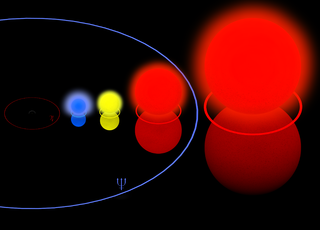| Observation data Epoch J2000.0 Equinox J2000.0 (ICRS) | |
|---|---|
| Constellation | Crater |
| Right ascension | 11h 38m 40.01668s [1] |
| Declination | −13° 12′ 06.9963″ [1] |
| Apparent magnitude (V) | 5.48 [2] |
| Characteristics | |
| Spectral type | F6.5 V [3] |
| B−V color index | +0.52 [2] |
| Astrometry | |
| Radial velocity (Rv) | −26.6±0.3 [4] km/s |
| Proper motion (μ) | RA: +99.52 [1] mas/yr Dec.: +125.99 [1] mas/yr |
| Parallax (π) | 37.41 ± 0.30 [1] mas |
| Distance | 87.2 ± 0.7 ly (26.7 ± 0.2 pc) |
| Absolute magnitude (MV) | +3.33 [5] |
| Details | |
| ι Crt A | |
| Mass | 1.19+0.06 −0.02 [6] M☉ |
| Surface gravity (log g) | 4.27±0.03 [7] cgs |
| Temperature | 6,230±21 [7] K |
| Metallicity [Fe/H] | −0.15±0.01 [7] dex |
| Age | 4.45+0.32 −0.94 [6] Gyr |
| ι Crt B | |
| Mass | 0.57 [8] M☉ |
| Other designations | |
| Database references | |
| SIMBAD | data |
Iota Crateris (ι Crateris) is the Bayer designation for a binary star [10] system in the southern constellation of Crater. It is faintly visible to the naked eye with an apparent visual magnitude of 5.48. [2] According to the Bortle scale, this means it can be viewed from suburban skies at night. Based upon an annual parallax shift of 37.41 mas, [1] Iota Crateris is located 87 light years from the Sun.
A Bayer designation is a stellar designation in which a specific star is identified by a Greek or Latin letter followed by the genitive form of its parent constellation's Latin name. The original list of Bayer designations contained 1,564 stars.

A binary star is a star system consisting of two stars orbiting around their common barycenter. Systems of two or more stars are called multiple star systems. These systems, especially when more distant, often appear to the unaided eye as a single point of light, and are then revealed as multiple by other means. Research over the last two centuries suggests that half or more of visible stars are part of multiple star systems.

A constellation is a group of stars that forms an imaginary outline or pattern on the celestial sphere, typically representing an animal, mythological person or creature, a god, or an inanimate object.
This is an astrometric binary system with an estimated orbital period of roughly 79,000 years. [10] The primary, component A, is an F-type main sequence star with a stellar classification of F6.5 V, [3] which is generating energy through the thermonuclear fusion of hydrogen in its core region. It is around 4.45 [6] billion years old with 1.19 [6] times the mass of the Sun. The star is radiating energy from its outer atmosphere at an effective temperature of 6,230 K. [7]

In astronomy, stellar classification is the classification of stars based on their spectral characteristics. Electromagnetic radiation from the star is analyzed by splitting it with a prism or diffraction grating into a spectrum exhibiting the rainbow of colors interspersed with spectral lines. Each line indicates a particular chemical element or molecule, with the line strength indicating the abundance of that element. The strengths of the different spectral lines vary mainly due to the temperature of the photosphere, although in some cases there are true abundance differences. The spectral class of a star is a short code primarily summarizing the ionization state, giving an objective measure of the photosphere's temperature.
Thermonuclear fusion is a way to achieve nuclear fusion by using extremely high temperatures. There are two forms of thermonuclear fusion: uncontrolled, in which the resulting energy is released in an uncontrolled manner, as it is in thermonuclear weapons and in most stars; and controlled, where the fusion reactions take place in an environment allowing some or all of the energy released to be harnessed for constructive purposes. This article focuses on the latter.

The solar mass (M☉) is a standard unit of mass in astronomy, equal to approximately 2×1030 kg. It is used to indicate the masses of other stars, as well as clusters, nebulae, and galaxies. It is equal to the mass of the Sun (denoted by the solar symbol ⊙︎). This equates to about two nonillion (two quintillion in the long scale) kilograms:
The companion, component B, is a red dwarf star with a probable classification of M3, although its mass estimate of 0.57 solar would be more consistent with an M0 class star. [8] As of 2014, this magnitude 11.0 star had an angular separation of 1.10 arc seconds along a position angle of 248°. [11] It has a projected separation of 25 AU, [8] which means it is positioned at least this distance away from the primary.

A red dwarf is a small and cool star on the main sequence, of M spectral type. Red dwarfs range in mass from about 0.075 to about 0.50 solar mass and have a surface temperature of less than 4,000 K. Sometimes K-type main-sequence stars, with masses between 0.50-0.8 solar mass, are also included.

Position angle, usually abbreviated PA, is the convention for measuring angles on the sky in astronomy. The International Astronomical Union defines it as the angle measured relative to the north celestial pole (NCP), turning positive into the direction of the right ascension. In the standard (non-flipped) images this is a counterclockwise measure relative to the axis into the direction of positive declination.


